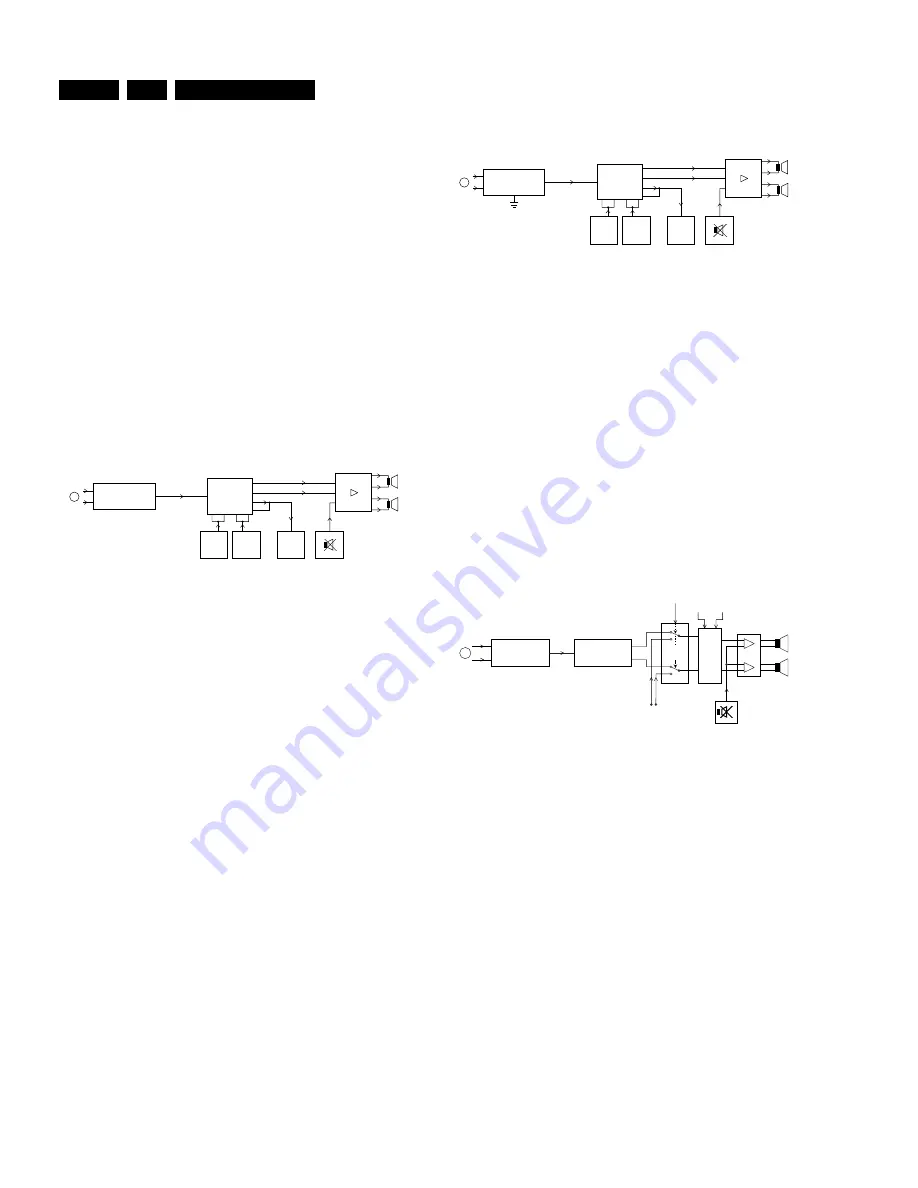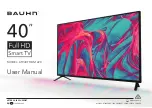
Circuit description new circuits
GB 58
L9.2A
9.
•
2CS : FM STEREO / FM MONO ( all standards 4.5, 5.5, 6.5
MHz )
•
BTSC : MONO/STEREO/STEREO-AP
MONO/AV STEREO, BTSC DBX incorporating 2CS (two
carrier stereo) use a TDA8841/42 BIMOS device (built-in Mono
FM Demodulator circuit).
The Audio Module incorporates for each system a different
multi digital sound processor.
•
MONO /AV STEREO: BSP3505 & TDA884x
•
NICAM / 2CS: MSP3415D
•
BTSC: TDA8841, TDA9851 and HEF4052
These IC's have an incorporate digital audio processing for
volume, bass, treble, balance, mute, spatial sound, incredible
sound, smart sound and source selection (SIF-signal, EXT1 or
EXT2).
9.4.1
MONO / AV STEREO
This set does have the digital sound processor BSP3505,
IC7833.
Figure 9-10 “MONO / AV STEREO SETS”
The video IF output is present at pin 11 of the tuner 1000. This
signal goes through a sound SAW filter and is fed to the BIMOS
via pins 48 and 49, where the signal is demodulated. . At pin 6
of BIMOS IC 7250-A, the SIF signal is fed to another SAW
filter. Signal Duall/Mono selects either SAW filter 1001 or SAW
filter 1002.
The system hardware configuration, option code SY, is set at
AD - Dual Mono for a Dual configuration, while option code SY
is set at SS for the Mono configuration ( BG,I, DK, M ). Via
Duall/Mono, a signal coming from the Micro-processor IC7600,
is possible to switch between two Mono configurations (BG/DK
or BG/I or DK/I).
This signal goes back to pin 1 of the BIMOS , for further
demodulation. The demodulated FM signal or the REAR I/O
audio signal, ExtAudioMono at pin 2, is switched by the BIMOS
and is present at pin 15.
The signal at pin 15 is fed to pin 55 of IC 7833 - BSP3505 - at
panel D1. IC 7833 performs source selection as well as audio
processing such as volume, bas, treble, balance, tone control
and spatial stereo. The audio output from IC 7833, pin 28 and
pin 29, is fed to the power amplifier IC 7950 or IC7951. Pin 36
and 37 pass the same selected signal through to the Audio-
cinches.
Signal Volume enables the output of the sound amplifier.
9.4.2
2CS
It is used on some cable television networks.
The diagram below indicates the AUDIO path for 2CS.
The CVBS + SIF signals present at pin 6 from BIMOS, -
TDA8844-, are passed through a high pass filter and are then
fed back into pin 58 of IC 7803 (MSP3415D) for further
demodulation. All variants of 2CS are demodulated in this IC.
Figure 9-11 “2CS”
Audio signals coming from the frontpanel are connected to pin
49/50 of IC7803 for the Ext1Audio signals, while pin 52/53 of IC
7861 are used for the Ext2Audio signals. IC 7803 performs
source selection as well as audio processing such as volume,
balance, tone control, mute, spatial stereo, incredible surround
sound and SMART sound. The audio output from IC 7803, pin
28 and pin 29, is fed to the power amplifier IC 7953 or IC7954.
Pin 36 and 37 pass the same selected signal through to the
audio-cinches. Signal Volume enables the output of the sound
amplifier.
9.4.3
BTSC
The SIF signal from the BIMOS are passed through a high pass
filter and are then fed back into pin 7 of IC 7861 (TDA9851) for
further demodulation. This signal is present at pin 6 of BIMOS
- TDA8841.
Figure 9-12 “BTSC”
Audio signals coming from the rear I/O panel are connected to
pin 5/14 of IC7802 for the Ext1Audio signals. The audio output
from IC 7802, performs the source selection via signal EXT 1 /
2. It is possible to switch between the demodulated BTSC
signal on the FRONT/EXT signal. Pin 3 and pin 13, are fed to
the power amplifier IC 7954. Signal Volume enables the output
of the sound amplifier.
9.5
Tuner and Video IF (see circuit diagram A5)
9.5.1
Introduction:
In Figure 9.13 a simplified block diagram of the video path is
shown. The main item in the block diagram shown in Fig.9.13
is the video processor item 7250. The IC performs the following
functions, video IF demodulation, chroma processing and RGB
processing. Additionally synchronisation processing, mono IF
audio demodulation and audio selection takes place.
One version of video processor is used:
•
TDA8844 N2 for SW CENELEC BG/DK, CENELEC I
NICAM, CENELEC BG NICAM
For a detailed block diagram of the TDA8844/8845 see Figure
9.12.
MONO/AV STEREO
TDA 8844
R
+
L
+
R
-
L
-
16
9
13
12
7953/7954
7803
EXT. 1
AUDIO
EXT. 2
AUDIO
CL 96532047_018.eps
020699
48
49
7250-A
AUDIO OUT
15
5
3
BSP3505
52
53
49
50
58
28
29
36
37
IF
LEFT OUT
RIGHT OUT
REAR
2CS
TDA 8844
R
+
L
+
R
-
L
-
8
13
10
11
7953/7954
7803
EXT. 1
AUDIO
EXT. 2
AUDIO
CL 96532047_019.eps
020699
48
49
7250-A
(SIF)
6
5
3
MSP3415
52
53
49
50
58
28
29
36
37
IF
LEFT OUT
RIGHT OUT
15
REAR
13(R)
12(L)
CL 96532047_026.eps
250599
TDA 8841
7250-A
SIF
48
49
TDA 9851
7861
7802
7
6
SMART
SOUND
BASS
TREBLE
FRONT
EXT1 Audio L
FRONT
EXT1 Audio R
1
5
3
13
12
14
4
2
8
6
16
13
9
12
HEF
4052
7954
EXT 1/2
IF
"BTSC"
Summary of Contents for L9.2A
Page 5: ...Directions for use GB 5 L9 2A 3 3 Directions for use ...
Page 6: ...Directions for use GB 6 L9 2A 3 ...
Page 7: ...Directions for use GB 7 L9 2A 3 ...
Page 8: ...Directions for use GB 8 L9 2A 3 ...
Page 9: ...Directions for use GB 9 L9 2A 3 ...
Page 10: ...Directions for use GB 10 L9 2A 3 ...
Page 11: ...Directions for use GB 11 L9 2A 3 ...
Page 12: ...Directions for use GB 12 L9 2A 3 ...










































